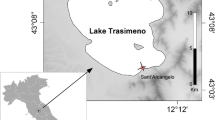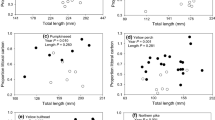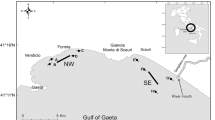Abstract
Invasive species often influence existing biocenoses by altering their environment or facilitating the ecology of other species. Here we combined stable isotope analysis with quantitative benthic community sampling to investigate temporal variation in the influence of biodeposition of organic material (biodeposits) by the zebra mussel (Dreissena polymorpha) on the benthic food web in hard substrate habitats of Lake Constance, Germany. The accumulation of organic material excreted by zebra mussels (faeces and pseudofaeces) is hypothesised to implement a biodeposition based food web. By means of stable isotope analyses, we found that the feeding strategy of amphipods was dependent on the availability of zebra mussel biodeposits. The proportion of pelagic resources contributing to the diet (by δ13C) and trophic position (by δ15N) of amphipods were significantly and positively correlated to the production of zebra mussel biodeposits. Also, the benthic community in Lower Lake Constance showed a shift towards higher densities of the mayfly Caenis spp., Chironominae, and the caddisfly Ecnomus tenellus, which might act as links to higher trophic levels when more zebra mussel biodeposits were available. These results demonstrate that temporal variation in zebra mussel density, and thus in organic biodeposition, have a strong impact on the benthic communities and food web structure associated with hard substrates to the extent that there may be dependence on zebra mussel occurrence in such habitats in Lake Constance.





Similar content being viewed by others
References
Baumgärtner D (2004) Principles of macroinvertebrate community structure in the littoral zone of Lake Constance. Dissertation, University of Konstanz
Baumgärtner D, Mörtl M, Rothhaupt KO (2008) Effects of water-depth and water-level fluctuations on the macroinvertebrate community structure in the littoral zone of Lake Constance. Hydrobiol 613:97–107
Baxter CV, Fausch KD, Murakami M et al (2004) Fish invasion restructures stream and forest food webs by interrupting reciprocal prey subsidies. Ecol 85:2656–2663
Bially A, MacIsaac HJ (2000) Fouling mussels (Dreissena spp.) colonize soft sediments in Lake Erie and facilitate benthic invertebrates. Freshw Biol 43:85–97
Chandra S, Gerhardt A (2008) Invasive species in aquatic ecosystems: issue of global concern. Aquat Invasions 3:1–2
Cleven EJ, Frenzel P (1993) Population dynamics and production of Dreissena polymorpha (Pallas) in River Seerhein, the outlet of Lake Constance (Obersee). Arch Hydrobiol 127:395–407
Dick JTA, Platvoet D (2000) Invading predatory crustacean Dikerogammarus villosus eliminates both native and exotic species. Proc R Soc Lond Ser B 267:977–983
Dick JTA, Platvoet D, Kelly DW (2002) Predatory impact of the freshwater invader Dikerogammarus villosus (Crustacea: Amphipoda). Can J Fish Aquat Sci 59:1078–1084
Dusoge K (1966) Composition and interrelations between macrofauna living on stones in the littoral of Mikolajskie Lake. Ekol Pol 14:755–762
France RL (1995a) Carbon-13 enrichment in benthic compared to planktonic algae: food web implications. Mar Ecol Prog Ser 124:307–312
France RL (1995b) Differentiation between littoral and pelagic food webs in lakes using stable carbon isotopes. Limnol Oceanogr 40:1310–1313
Garton DW, Payne CD, Montoya JP (2005) Flexible diet and trophic position of dreissenid mussels as inferred from stable isotopes of carbon and nitrogen. Can J Fish Aquat Sci 62:1119–1129
Gergs R, Rothhaupt KO (2008a) Effects of zebra mussels on a native amphipod and the invasive Dikerogammarus villosus: the influence of biodeposition and structural complexity. J N Am Benthol Soc 27:541–548
Gergs R, Rothhaupt KO (2008b) Feeding rates, assimilation efficiencies and growth of two amphipod species on biodeposited material from zebra mussels. Freshw Biol 53:2494–2503
Gergs R, Rinke K, Rothhaupt KO (2009) Zebra mussels mediate benthic-pelagic coupling by biodeposition and changing detrital stoichiometry. Freshw Biol 54:1379–1391
González MJ, Burkart GA (2004) Effects of food type, habitat, and fish predation on the relative abundance of two amphipod species, Gammarus fasciatus and Echinogammarus ischnus. J Great Lakes Res 30:100–113
Hesselschwerdt J, Necker J, Wantzen KM (2008) Gammarids in Lake Constance: habitat segregation between the invasive Dikerogammarus villosus and the indigenous Gammarus roeselii. Fund Appl Limnol 173:177–186
IGKB (2004) Der Bodensee Zustand-Fakten-Perspektiven. http://www.hydra-institute.com/igkb/inhalt.html. Accessed Jan 2004
Izvekova EI, Lvova-Katchanova AA (1972) Sedimentation of suspended matter by Dreissena polymorpha Pallas and its subsequent utilization by chironomidae-larvae. Pol Arch Hydrobiol 19:203–210
Kinzler W, Maier G (2003) Asymmetry in mutual predation: possible reason for the replacement of native gammarids by invasives. Arch Hydrobiol 157:473–481
Klerks PL, Fraleigh PC, Lawniczak JE (1996) Effects of zebra mussel (Dreissena polymorpha) on seston levels and sediment deposition in western Lake Erie. Can J Fish Aquat Sci 53:2284–2291
Langeland A, Koksvik JI, Nydal J (1991) Impact of the introduction of Mysis relicta on the zooplankton and fish populations in a Norwegian Lake. Am Fish Soc Symp 9:98–114
Letnic M, Koch F, Gordon C et al (2009) Keystone effects of an alien top-predator stem extinctions of native mammals. Proc R Soc Lond Ser B 276:3249–3256
Limén H, van Overdijk CDA, MacIsaac HJ (2005) Food partitioning between amphipods Echinogammarus ischnus, Gammarus fasciatus, and Hyalella azteca as revealed by stable isotopes. J Great Lakes Res 31:97–104
Lorenzen CJ (1967) Determination of chlorophyll and pheo-pigments: spectrophotometric equations. JSTOR 12:343–346
Maguire CM, Grey J (2006) Determination of zooplankton dietary shift following a zebry mussel invasion, as indicated by stable isotope analysis. Freshw Biol 51:1310–1319
McCutchan JH, Lewis WM, Kendall C et al (2003) Variations in trophic shift for stable isotope rations of carbon, nitrogen, and sulfur. Oikos 102:378–390
Mitchell J, Mills EL, Idrisi N et al (1996) Stable isotopes of nitrogen and carbon in an aquatic food web recently invaded by Dreissena polymorpha (Pallas). Can J Fish Aquat Sci 53:1445–1450
Morin A, Lamoureux W, Busnarda J (1999) Empirical models predicting primary productivity from chlorophyll a and water temperature for stream periphyton and lake and ocean phytoplankton. J N Am Benthol Soc 18:299–307
Mörtl M (2004) Biotic interactions in the infralittoral of Lake Constance. Dissertation, University of Konstanz
Mörtl M, Rothhaupt KO (2003) Effects of adult Dreissena polymorpha on settling juveniles and associated macroinvertebrates. Int Rev Hydrobiol 88:561–569
Peters L, Scheifhacken N, Kahlert M et al (2005) An efficient in situ method for sampling periphyton in lakes and streams. Arch Hydrobiol 163:133–141
Peterson BJ, Fry B (1987) Stabile isotopes in ecosystem studies. Annu Rev Ecol Syst 18:293–320
Platvoet D, van der Velde G, Dick JTA et al (2009) Flexible omnivory in dikerogammarus villosus (Sowinsky, 1894)—amphipod pilot species project (AMPIS) report 5. Crustaceana 82:703–720
Post DM (2002) Using stable isotopes to estimate trophic position: models, methods, and assumptions. Ecol 83:703–718
R Development Core Team (2006) R: a language and environment for statistical computing. R Foundation for Statistical Computing, Vienna, Austria
Ricciardi A, MacIsaac HJ (2000) Recent mass invasion of the North American great lakes by Ponto-Caspian species. Trends Ecol Evol 15:62–65
Roditi HA, Strayer DL, Findlay SEG (1997) Characteristics of zebra mussel (Dreissena polymorpha) biodeposits in a tidal freshwater estuary. Arch Hydrobiol 140:207–219
Scheifhacken N, Fiek C, Rothhaupt KO (2007) Complex spatial and temporal patterns of littoral benthic communities interacting with water level fluctuations and wind exposure inthe littoral zone of a large lake. Fund Appl Limnol 169:115–129
Silver Botts P, Patterson BA, Schloesser DW (1996) Zebra mussel effects on benthic invertebrates: physical or biotic? J N Am Benthol Soc 15:179–184
Stewart TW, Haynes JM (1994) Benthic macroinvertebrate communities of Southwestern Lake Ontario following invasion of Dreissena. J Great Lakes Res 20:479–493
Stewart TW, Miner JG, Lowe RL (1998) Quantifying mechanisms for zebra mussel effects on benthic macroinvertebrates: organic matter production and shell-generated habitat. J N Am Benthol Soc 17:81–94
Ten Winkel EH, Davids C (1982) Food selection by Dreissena polymorpha Pallas (Mollusca: Bivalvia). Freshw Biol 12:553–558
van der Velde G, Leuven RSEW, Platvoet D et al (2009) Environmental and morphological factors influencing predatory behaviour by non-indigenous gammaridean species. Biol Invasions 11(9):2043–2054
Vander Zanden MJ, Casselman JM, Rasmussen JB (1999) Stable isotopes evidence for the food web consequences of species invasions in lakes. Nature 401:464–467
Walz N (1978a) The energy balance of the freshwater mussel Dreissena polymorpha PALLAS in laboratory experiments and in Lake Constance I. Pattern of activity, feeding and assimilation efficiency. Arch Hydrobiol 55(Suppl):83–105
Walz N (1978b) The production and significance of the Dreissena population in the nutrient cycle in Lake Constance. Arch Hydrobiol 82:482–499
Ward JM, Ricciardi A (2007) Impacts of Dreissena invasions on benthic macroinvertebrate communities: a meta-analysis. Divers Distrib 13:155–165
Werner S, Mörtl M, Bauer HG et al (2005) Strong impact of wintering waterbirds on zebra mussel (Dreissena polymorpha) populations at Lake Constance, Germany. Freshw Biol 50:1412–1426
Wessels M (1998) Geological history of the Lake Constance area. Arch Hydrobiol Adv Limnol 53:1–12
Wisenden PA, Bailey RC (1995) Development of macroinvertebrate community structure associated with zebra mussel (Dreissena polymorpha) colonization of artificial substrates. Can J Zool 73:1438–1443
Acknowledgments
We thank the scientific diving group of the Limnological Institute of the University of Konstanz for cooperation in field sampling, especially Stefan Werner, John Hesselschwerdt, Martin Wolf and Manuel Hirning. Christoph Berron contributed to identifying and counting macroinvertebrates from benthos samples. Petra Merkel and Silvia Ballert helped with preparation of stable isotope samples. We also thank Dr. Dominik Martin-Creuzburg, André Gergs and Melanie Hartwich for comments on an earlier version of the manuscript. This work was supported by the German Research Foundation within the collaborative research centre SFB 454 Littoral of Lake Constance.
Author information
Authors and Affiliations
Corresponding author
Rights and permissions
About this article
Cite this article
Gergs, R., Grey, J. & Rothhaupt, KO. Temporal variation in zebra mussel (Dreissena polymorpha) density structure the benthic food web and community composition on hard substrates in Lake Constance, Germany. Biol Invasions 13, 2727–2738 (2011). https://doi.org/10.1007/s10530-011-9943-8
Received:
Accepted:
Published:
Issue Date:
DOI: https://doi.org/10.1007/s10530-011-9943-8




